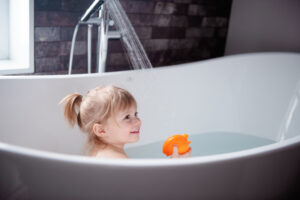Bath Tub Safety for Kids
Splish-splash, it’s bath time! The bath can be a great place to play, work on sensory and motor skills, and even learn about the importance of staying clean! It can also be a key part of your little one’s routine. When it comes to bath tub safety, there are some extra steps to take during bath time. Because there’s water, soap, and hard surfaces involved, it’s important to teach babies and kids how the guidelines for bath tub safety as they scrub-a-dub and learn to develop a hygiene routine.
Here are some bath tub safety tips to make the whole process safe and squeaky clean.
Start with a sponge bath.
When baby is in the first week or two after birth, it may be safest to give them a sponge bath. Sponge baths are recommended until the umbilical cord stump falls off and the bellybutton heals, which for some babies is up to 2 weeks.
After that, baby is ready to use a baby tub or the sink.
Babies usually use these special baths for about 6 months, but that can differ depending on baby’s size and abilities. Baby is not ready for an actual bathtub until they can sit up on their own and control their body while sitting up. Additionally, if baby is smaller, they may not outgrow the baby bathtub for several more months—and that’s ok!
No matter if baby is in the sink, a baby tub, or the bathtub, never leave a baby or child unattended.
For a newborn, you should always keep your hands on them. For a child that can sit independently in the tub, always be within arm’s reach.
Make sure the water is not too hot or cold.
Ideally, it will be around 100 degrees Fahrenheit. The air temperature matters too, because you don’t want baby to get too cold when they get out of the bath. The ideal air temperature for baby is around 75 to 80 degrees Fahrenheit. To have better control over the water temperature, sometimes it helps to put water in the tub before baby gets in.

Keep the water shallow.
When we think of a bath as an adult, we picture filling the tub up most of the way and submerging everything but our head. But for a baby, the water should actually be very shallow, and most of their body will be out of the water. It is recommended the water height is about 2 inches. You can then use a cup to scoop up water and pour it on baby’s body throughout the rest of the bath.
Keep the area slip-free and baby-proofed.
Use non-skid mats to prevent slipping, and always thoroughly wash off all soap and shampoo with water. Use a soft-spout cover or a pool noodle to cover the water spout, in case baby bumps their head on it.
Only use a small amount of soap.
Soap is great for getting us clean! But too much makes things extra slippery. It can also dry out baby’s skin. Just a small amount with some water can go a long way.
Be sensitive to sounds.
Baby may get upset by some of the unusual sounds they hear in the bathroom, such as running water or flushing toilets. Even your voice may sound different in a bathroom. Be sure to speak to baby in a soft, quiet voice and avoid loud sounds to create a calming environment for baby.
At the end of the bath, dry baby off as thoroughly as possible.
This is not only good for their skin health, but makes them easier to handle! Drying can also be a calming sensory experience for baby.
Create a “no running in the bathroom” rule.
If your children are old enough to walk and run, teach them to never run in the bathroom and the tub. It can be hard to tell where there may be water or soap on the ground, so it’s best to walk carefully!
Unplug all electrical appliances.
As children get older and can move around independently, you’ll want to make sure that there is no chance of any electrical appliances getting wet or in the bathtub. It is recommended appliances remain unplugged when not in use, and if possible, are stored in a separate room.
Once you get the hang of bathing your little one, these guidelines will feel like second nature. Learn more about establishing a bath time routine.

